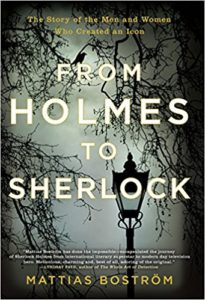If Sir Arthur Conan Doyle were alive today, he would be 158 years old. The fact that his creation, Sherlock Holmes, is alive in the twenty-first century in newly minted versions on the screen and in books, is a testament to the lasting power of Doyle’s amazing character.
 Created in the 1870s, Sherlock Holmes has gone through so many interpretations that it took Mattias Boström, noted Swedish author, 500 pages to describe the many incarnations of this fictional character. His book, From Holmes to Sherlock: The Story of the Men and Women Who Created an Icon, recreates the amazing industry that has grown around Sherlock Holmes over the last one hundred and forty years. The characters are all here: Holmes, Watson, the Baker Street Irregulars, Mrs. Hudson, Mycroft, Irene Adler, and even Moriarty. Any Holmes enthusiast will love the vignettes, snippets, and trivia in this book. In 111 chapters, 45 pages of footnotes, and 23 pages of bibliography, Boström threads them together in a chronological pattern to illustrate the detective’s conversion from “Holmes” to “Sherlock.”
Created in the 1870s, Sherlock Holmes has gone through so many interpretations that it took Mattias Boström, noted Swedish author, 500 pages to describe the many incarnations of this fictional character. His book, From Holmes to Sherlock: The Story of the Men and Women Who Created an Icon, recreates the amazing industry that has grown around Sherlock Holmes over the last one hundred and forty years. The characters are all here: Holmes, Watson, the Baker Street Irregulars, Mrs. Hudson, Mycroft, Irene Adler, and even Moriarty. Any Holmes enthusiast will love the vignettes, snippets, and trivia in this book. In 111 chapters, 45 pages of footnotes, and 23 pages of bibliography, Boström threads them together in a chronological pattern to illustrate the detective’s conversion from “Holmes” to “Sherlock.”
Conan Doyle based Sherlock Holmes on an instructor of clinical surgery at the Royal Infirmary, Edinburgh, named Dr. Joseph Bell, whose uncanny diagnoses inspired the process used by Sherlock Holmes to solve crimes. When Conan Doyle was twenty, he took notes on Bell’s lectures. A doctor himself, he began the Holmes stories with stops and starts. Eventually, fifty-six short stories and four novels comprised the Holmes titles. Conan Doyle’s frustration at making money with the detective stories when he’d rather be writing more noteworthy books is evident from the early days. It was a love-hate relationship with which Conan Doyle eventually made peace, but not before killing Holmes and bringing him back.
An industry, culture, and world grew up around Sherlock Holmes. It would be impossible to name the many areas explored by Boström. However, the following are some that stood out as I read.
The author, and eventually the estate, tried at various times to guard the detective’s persona. Some family members did so out of greed, and others were determined to safeguard their father’s or grandfather’s legacy. Because of this, much of the book describes intriguing copyright and legal issues constantly evolving around the stories, plays, and movies.
Boström also describes the various literary figures surrounding Sir Arthur Conan Doyle: J.M. Barrie, Jerome K. Jerome, Bram Stoker, P.G. Wodehouse, John Galsworthy, G.K. Chesterton, and Rudyard Kipling. Actors who gained great fame or notoriety playing Holmes include William Gillette, Basil Rathbone, Jeremy Brett, Peter Cushing, Michael Caine, Robert Downey Jr., Benedict Cumberbatch, and Jonny Lee Miller. They are all in Boström’s book. The stories about the early illustrators are equally enthralling. Over many decades, clubs and groups grew up around the detective, some of them still in existence today. Most notably, The Sherlock Holmes Society of London, the Speckled Band of Boston, the Five Orange Pips, and the Sherlockians, play key roles in the story of how a love for Holmes created fandom.
Boström also digs into other topics that relate to Conan Doyle. He describes the Strand Magazine, still published today, whose

My own much-thumbed two-volume Holmes tales
circulation depended on the serialization of the Holmes stories during Conan Doyle’s time. The Conan Doyle family, including wife Louisa, bought various homes, raised children, and had a robust social life. Conan Doyle’s interest in psychics and life after death plays a major role in the book and was the subject of several of his lecture tours. Boström describes vividly the publishing world through all these years, the copyright difficulties in Europe, America, and England, and the family’s involvement in litigation.
The chapters describing the most recent years include discussions of the four Conan Doyle children—Mary, Denis, Adrian, and Jean—and the estate tax problems. Throughout recent years, reincarnations of the characters and stories have brought the detective to life for new generations on many continents. Some projects worked, while others were failures. Included in the more recent history are books and films written by others. Nicholas Myer’s The Seven-Per-cent Solution, Disney productions about a mouse detective named Basil, Young Sherlock Holmes, The Private Life of Sherlock Holmes, and the Mary Russell books by Laurie R. King are just a few of the projects described as modern recreations.
Any Sherlock Holmes aficionado will enjoy reading Boström’s book because it is chock full of details and sometimes little-known facts about the detective and his creator. Boström has studiously foot noted and claimed every source in the 111 chapters. However, at times I felt he could use some good editing. For example, who cares what Basil Rathbone’s golf handicap was when he was working on films in California? Occasionally, I exclaimed, “Seriously? You include that?” I was also thrown off at first by the order of the material. While it is mostly chronological, occasionally Boström goes back and picks up a thread and discusses it out of chronological order. This confused me when he spoke of Conan Doyle in the present tense after he had passed away several chapters earlier. Once I figured out why he was doing that, it made sense.
I would recommend this weighty tome to Sherlock Holmes fans. The wealth of information is amazing, the stories interesting, and the documentation superb.
Mattias Boström’s book won the nonfiction award from the Swedish Crime Writers’ Academy and was shortlisted for Best Swedish Nonfiction Book of the Year. He is a Swedish author, publisher, and Sherlock Holmes expert.

This looks like a good book. I may have to spend my Christmas money on it!
It is an amazing book if you like Sherlock Holmes. I found it hard to put down, and the interesting bits of information he found were just amazing.
Benedict Cumberbatch is the first actor to re-define my imagination of Holmes since Basil Rathbone. Cushing was also quite good. Holmes was such a complex and dark character. Hard to portray, yet seemingly more real than many actual historical figures. Happy 158th birthday, Sherlock! Many more.
I love watching Cumberbatch in the “Sherlock” series. Too bad they don’t make them faster. The imaginations of the writers and producers of that modern-day retelling are marvelous. This book connects the various actors who played Holmes and discusses their differences in interpretations. Often you read what the Conan Doyle family thought about the portrayals. The fact that Sherlock still gets mail at 221B Baker Street certainly supports your point!
The whole Cumberbatch production was was like further bad episodes of Dr Who, with shockingly poor story lines. I believe the only actor to breath real life into the character was Jeremy Brett.
Well, I’ll let you discuss that with David. I think one of the great things about Bostrom’s new book is that he includes so many different interpretations of various Sherlock Holmes actors. DeYoung is saying that FOR HIM the Cumberbatch interpretation resonated. Obviously, for you it was Jeremy Brett.